The production workshop of the pharmaceutical factory is different from the general comfortable air-conditioned room. The indoor temperature and humidity control requires high precision. Generally, the temperature is required to be 22 °C ± 2 °C, the relative humidity is within 55% ± 5%, and the cleanliness of the air is required. There are also higher requirements, so that the number of air changes is more, the fresh air volume is large, and there is even a direct exhaust system. Because the external temperature and humidity changes have a great influence on the indoor temperature and humidity, only by selecting a reasonable temperature and humidity control scheme can the indoor temperature and humidity meet the design requirements. Aiming at the common problems of industrial air-conditioning systems using traditional control methods, this paper proposes a control scheme, which helps to improve the operation effect and economy of air-conditioning systems.
1 Characteristics And Common Problems Of Temperature And Humidity Control
Characteristics Of temperature And Humidity Control
The simple heating or cooling process of humid air is a process in which the moisture content remains unchanged, that is, a process in which the absolute humidity remains unchanged. The humid air is heated by the coil, the temperature increases and the relative humidity decreases; on the contrary, for the cooling process, the temperature decreases and the relative humidity increases accordingly, so we can conclude that temperature and relative humidity are control quantities in two different directions. And to make the temperature and humidity change to the same trend at the same time, it cannot be achieved simply by the heating/cooling process. The cooling and dehumidification process is a process in which the humid air is cooled to saturation and then continues to cool. The humid air passes through the cooling coil to separate out water droplets, thereby reducing the absolute humidity and dehumidifying. Therefore, we can divide the air treatment process into five parts: heating, heating and humidifying, cooling, cooling reheating and cooling and humidifying, as shown in Figure 1.
In Figure 1, the abscissa is the moisture content, that is, the amount of water vapor contained in each kilogram of dry air; the ordinate is the temperature. From the absolute humidity line of the target state, the target temperature and target humidity line, and the dangerous warning humidity line of the machine dew point (relative humidity is 95%), it can be divided into 5 control states, see Table 1 for details.
According to the local climate, we divided different areas, namely the remote work area (outside the shaded area), the work area (the shaded area) and the tolerance area. The control method of large-step approximation will be used far away from the working area, and the intelligent control strategy described in this paper will be adopted in the working area to keep the state of each valve within the tolerance.
1.2 Methods used in the actual process and common problems
1.2.1 Control problems of hot and cold water valves
The direction of temperature change is opposite to the direction of action of the cold/hot water valve, usually using a separate operation mode in winter and summer. Such an approach will make it difficult to judge and determine the operation mode in excessive seasons, and it is easy to cause the imbalance of indoor temperature and humidity.
1.2.2 Conventional handling methods and problems
In order to solve the problem of dehumidification, the humidity priority method is usually adopted. The cold water valve is mainly used for dehumidification, which also causes the temperature to drop. Then, the temperature and humidity can reach the required value through the reheating of the hot water valve. It can meet the design requirements, but in quite a few times, the hot and cold water valves make the energy offset each other, resulting in a waste of energy. According to statistics, in my country, the energy consumption of air-conditioning system accounts for 50% to 60% of the energy consumption of the whole building. Therefore, it is of great significance to optimize the control of air-conditioning equipment and select a reasonable control method for building energy conservation.
It is difficult to set the PID parameters in a suitable range by simply adopting the closed-loop control of the return air temperature to control the cold/hot water valve to control the indoor temperature, and it is difficult to ensure the stability and accuracy of the system. If the adjustment action is slow, the pre-start time is too long, and the adjustment action is fast, it is easy to cause the overshoot of the system, and even produce oscillation.
2 Implementation of the control system
2.1 Design of the control system
The temperature and humidity control of the clean room of the pharmaceutical factory is a multi-variable control object. The temperature control and humidity control affect each other, and their dynamic characteristics are quite different, especially the correlation between temperature and humidity is strong, so we use cascade and split-range control methods to avoid the occurrence of the above problems.
In each delay control link, the temperature and humidity value detected by the temperature and humidity transmitter is compared with the current target temperature and humidity state to determine its working range and fuzzy partition, and automatically match the proper control state. And the following control strategy is adopted in each fuzzy partition, and the set value is the value required by the current clean room.
According to the characteristics of the cascade control system: the secondary loop has a fast action, it can effectively overcome the influence of the secondary disturbance, plays the role of improving the dynamic characteristics of the object, and plays the role of “coarse adjustment” in the control process; the closed loop is called the main loop, which is used to complete the “fine adjustment” task to finally ensure that the controlled quantity meets the process requirements. Although there are two regulators in the cascade control system, their functions are different. The main regulator has its own independent set value, and its output is used as the set value of the secondary regulator, which plays a leading role in the system. The secondary loop mainly overcomes external disturbances, while the main loop mainly overcomes internal disturbances.
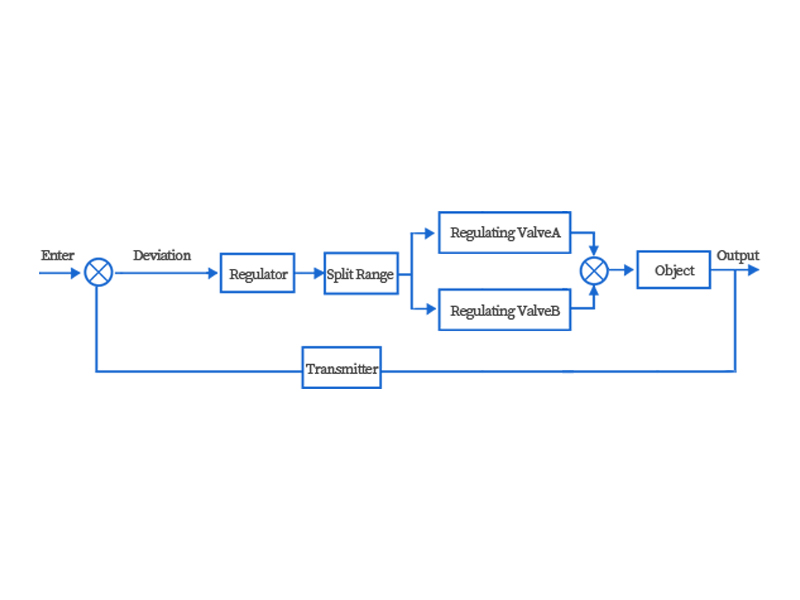
Taking into account the need for energy saving, a split-range control method is adopted. In order to prevent the cold and hot water valves from being opened at the same time, the split-range control is used when controlling the cold and hot water valves, as shown in Figure 2. The control process is as follows: the output of the controller can be converted into a symmetrical interval range through software, such as -100% to 100%, and divided into two signal outputs after the split-range process, namely -100% to -5% ( can be changed) and 5% to 100%. Since the cold/hot water valve cannot be switched too fast, there is a delay process, and then the two signals are used to control the opening of the hot water valve and the cold water valve respectively, as shown in Figure 3. The realization of split range is realized by software (PG5 software of Saia Company) through the module SEQ-HC.
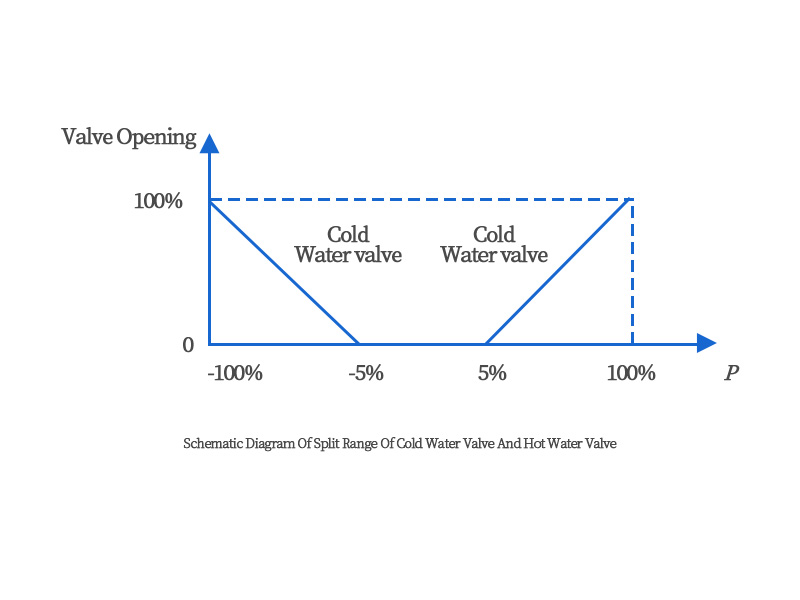
In Figure 3, the X axis represents the control signal P, and the Y axis represents the valve opening. When P is -100%, the cold water valve is fully open, and when P is -5%, it is fully closed; when P is 100%, the hot water valve is fully open, and when P is 5%, it is fully closed, and -5% to 5% is the delay process.
2.2 Implementation of the control system
In the industrial air-conditioning system with large space, large inertia and large delay, we use the PI control method to prevent the system from oscillating. The system adopts the three-stage cascade control method of temperature and humidity, and sets the PI control dead zone. The method of self-adaptive adjustment is adopted to avoid the oscillation of the system and ensure the control accuracy of the system.
2.2.1 Temperature Cascade Process
Since the supply air temperature fluctuates greatly due to interference, it is set as the secondary ring, the return air temperature is set as the main ring, and the dead zone is set in the secondary ring, which can well satisfy the stable adjustment of the indoor temperature. The adjustment process of the main loop is slow, and the adjustment process of the auxiliary loop is faster, so that the room temperature can reach the required value quickly after starting up, and the overshoot of the system is also suppressed. Without considering humidity, the cascade flow chart of supply air temperature and return air temperature is shown in Figure 4.
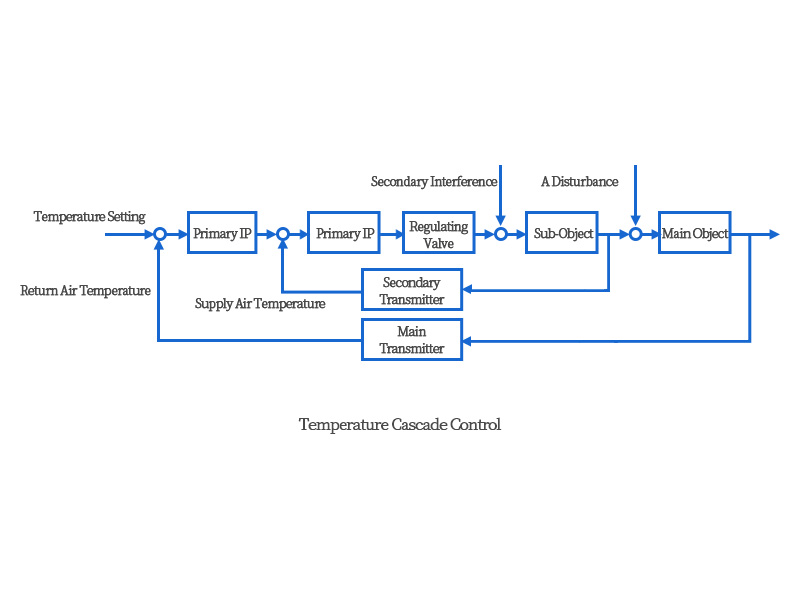
2.2.2 System flow chart
Since the cold water valve is jointly controlled by temperature and humidity, the cascade control of humidity is also added, so the flow chart of the whole system is shown in Figure 5. The cascade control output of supply air and return air temperature is controlled by split range, and the signal from -100% to -5% (to be converted by digital-to-analog) and the signal from -100% to -5% of humidity control after split range are superimposed to jointly control the cold water valve. The 5% to 100% signal after the temperature split range directly controls the opening of the hot water valve, and the 5% to 100% signal after the humidity split range controls the humidification valve.
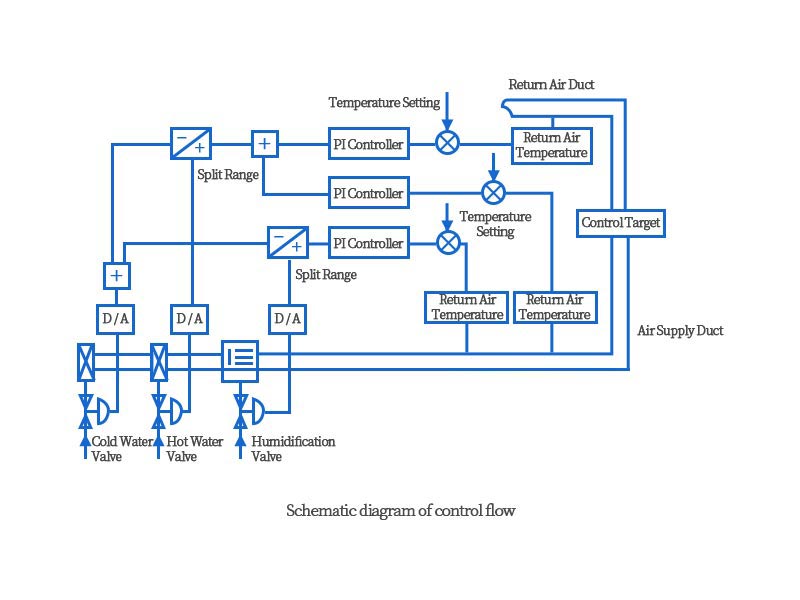
2.3 Decoupling of temperature and humidity
According to the principle of air conditioning, in the control of air-conditioning system, especially in the air-conditioning system with constant temperature and humidity, it is very important to solve the coupling problem between air temperature and relative humidity, which will directly affect the control accuracy. In order to solve the above problems, the method of decoupling must be adopted, and that is, the decoupling links R1 and R2 are introduced between the temperature and humidity control loops, so that the temperature and humidity control becomes:
Temperature output T=Kt[(1-R1)×Ct+R1×Ch]
Humidity output H=Kh[(1-R2)×Ch+R2×Ct] where: R1=0~1; R2=0~1.
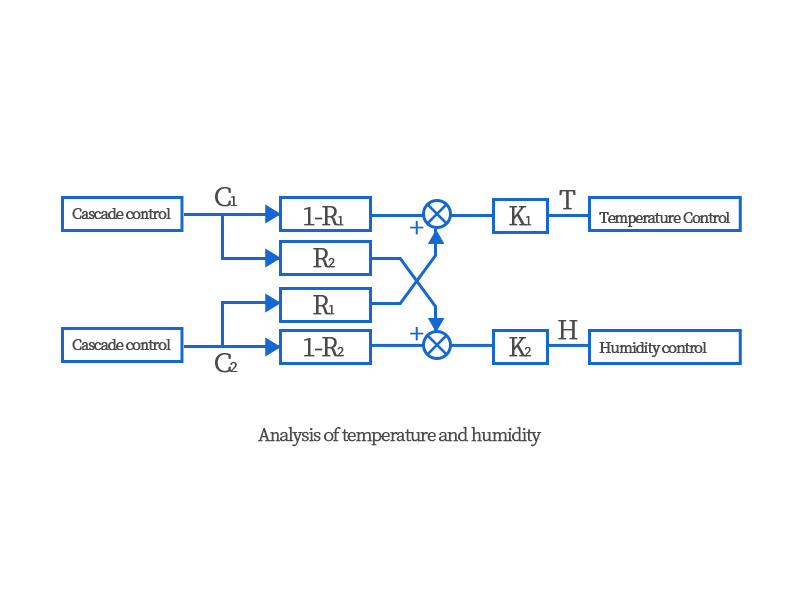
Kt and Kh are coefficients determined to improve the control accuracy. The actual values of R1 and R2 are 0 to 1, and in different seasons or under different loads, they need to be adjusted separately. The specific method is to first set R1=R2=0, at this time, whenever heating or dehumidification is started, it will cause a large fluctuation of temperature and humidity in the clean room, and then gradually increase R1 and R2 according to the situation to reduce this fluctuation, and finally achieve the purpose of decoupling control.
2.4 Features of the control system
①The cold water valve, hot water valve and humidification valve are respectively controlled by split range, which can overcome the problem of difficult to judge the transition season caused by the switching mode between winter and summer.
②The cold water valve adopts cascade control of supply air temperature, return air temperature, and supply air humidity, and sets dead zone, which better solves the problem of overshoot of temperature and humidity, and has better stability, thereby improving the control accuracy of the system as well as reducing energy waste.
3 Conclusion
The control method has achieved practical results in the application of the clean room of Factory and the clean room temperature and humidity control system of Pharmaceutical Industry, effectively suppressing the overshoot of the system, and will not cause waste of energy, and the control effect is relatively ideal, the operation is relatively simple, which has achieved the goal of high efficiency and low cost of clean room operation in pharmaceutical factories.










